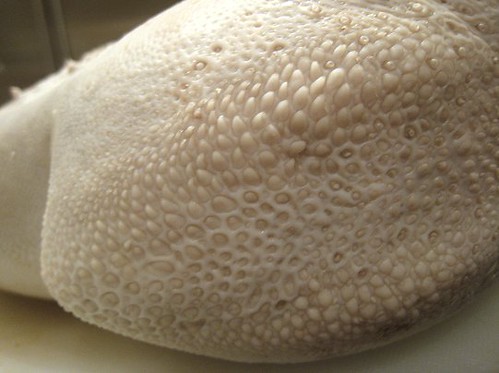
Looks like a white strawberry, the texture. Doesn't it?
[ts]
After a Christmas gathering at our cousin's house where lengua was served, I decided that we should serve it during one of our parties at home.
When we chose Spanish as the theme for our New Year's Party, I thought, perfect! After all, "lengua" is Spanish. ;)
[js]
I remember lengua being a "festive" dish, that is, it always seemed to be a fixture in Philippine holiday parties. I remember liking lengua, but I don't recall if TS ever eating lengua herself.
Which is why I was a tad surprised when she was so insistent on doing lengua for the party. She isn't a "variety meat" kind of gal.
[ts]
I don't get why tongue is classified as offal.
It's still just muscle, people, it's not innards!
We were counting on buying cleaned and peeled beef tongues for the party, but couldn't find them. My mind was still set on serving lengua, however, so we went ahead and bought the available frozen, unpeeled tongue. How hard could cleaning it be, right?
I read up on tongue cookery in 1080 Recipes(the Spanish equivalent of The Silver Spoon), and even looked at The Silver Spoon
as well.
I was ready.
Lengua Prep
[ts]
We left the tongue in the fridge to defrost for about a day, then soaked them in cold water. They weren't totally defrosted yet, but we didn't have the time to wait for that. Besides, the soaking in water would help in the defrosting anyway. They soaked overnight; actually, for about 12 hours.
Then, they were ready.
According to 1080 Recipes, one can either peel tongue before braising them or after braising them. I opted to do the former as I was afraid the flavors would not be infused into the meat with its skin still on.
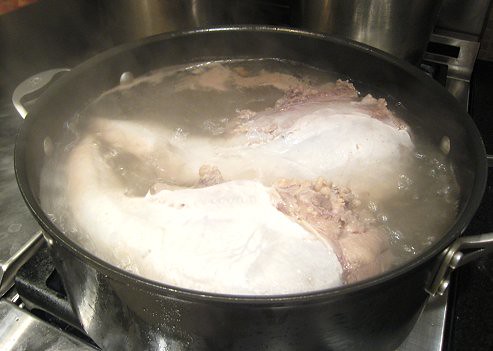
"cleaning" the meat by blanching
[ts]
I brought a pot of water to boil, then plunged the tongues in for about 15 minutes. I had to do this in two batches as we had no pot big enough to contain four tongues. I imagine this is to "clean" the tongue; this technique is often used in Chinese cooking as well.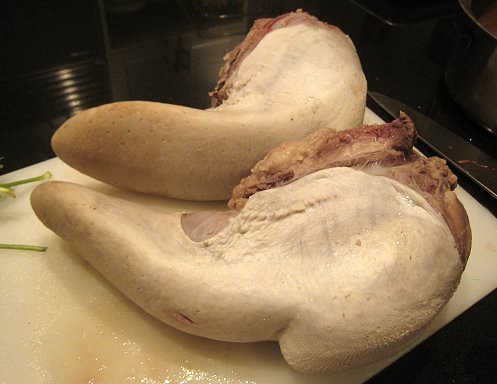
The tongue is a huge muscle! Look at that back end.
[ts]
When they were cool enough to handle, I started the task of peeling them. Well, I thought it would be like peeling the peel off of bananas, but no! Apparently, that only happens if I had peeled them after braising.
Basically, I had to peel the tongue by shaving off the skin with a boning knife. It was a little time-consuming -- the skin was a little tough and my knife could be sharper -- but I guess I got better with practice. =)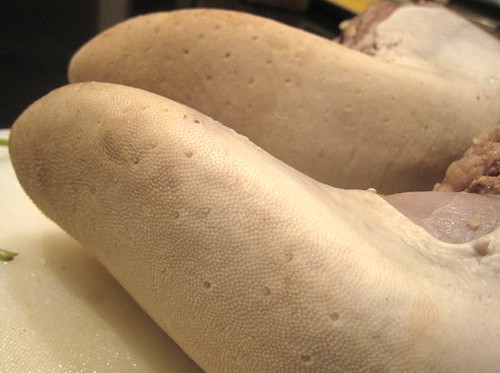
Behold, papilae!
[js]
The peeling is not the task for me. If it were me trying to peel the tongue, I would have just sliced off big slivers of tongue-skin with tongue-meat still attached to make my life a whole lot easier. We would have been left with rectangular blocks of beef tongue.
[ts]
The peeling was the most difficult part. After that, it was basically a shove-everything-into-a-pan-and-forget-about-it recipe.
Veal Stock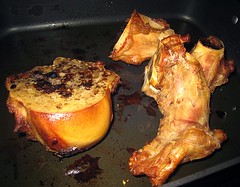
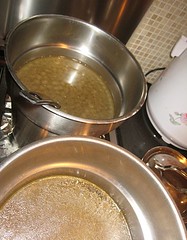
[ts]
We made veal stock the night before. JS simply roasted some bones until nice and brown, and placed the bones in a pot with some cold water. We simmered the bones overnight.
Braising
[ts]
In my braising pan (which in our case, was the largest roasting pan we owned), I sweated some onions and carrots. I didn't add celery because from perusing 1080 Recipes, it seems that the Spanish, or at least this cookbook author, do not use a lot of celery in their flavor base. I also added some tomatoes, but just a small amount. This dish wasn't intended to be a tomato-based one.
The tongues went in, along with the rest of the flavorings: black peppercorns, parsley, bay leaves and thyme. I also added a pinch of ground cinnamon and a couple of cloves for a little something-something. We also had half a can of anchovies lying around so I threw those in to use them up.
For our braising liquid, we did a combination of red wine (because we had about half a bottle that was in danger of turning to vinegar) and veal stock.
I added the liquids to the roasting pan, brought the mixture to a boil, then covered the pan and placed it in the oven. I let the lengua braise for about 3 or 4 hours, until they were tender.
Braised lengua in their braising liquid, cooled.
That's congealed beef fat encasing them. Beef fat! Nice.
[ts]
In our case, we braised these tongues the day before the party. That only served to intensify the flavors, we believe. They were left to cool in the braising liquid.
The next day, I took the lengua out of the liquid and sliced them. We strained the braising liquid and reduced it, adjusting the seasoning at the end.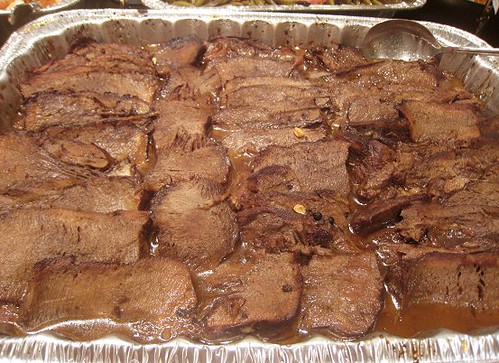
Bad photo of sliced lengua with its sauce.
[js]
The transformation!
Sliced, they don't look anything like the tongue they started out in life as. In fact, they just look like regular old beef, except much more tender and much more flavorful.
There is nothing quite like the tenderness of the tongue: for some reason, tongue still retains a very nice chew even when very tender. It keeps its integrity and doesn't shred like brisket or short ribs, for example.
I was a little apprehensive how the lengua was going to be received at the party. Going in, I knew some people (like my father) love lengua, but given that it is not a common cut in Vancouver, I was afraid that some guests would not even be persuaded to try it.
Judging by the leftovers (we only had a few pieces left at the end of the night), I would say it was quite a success.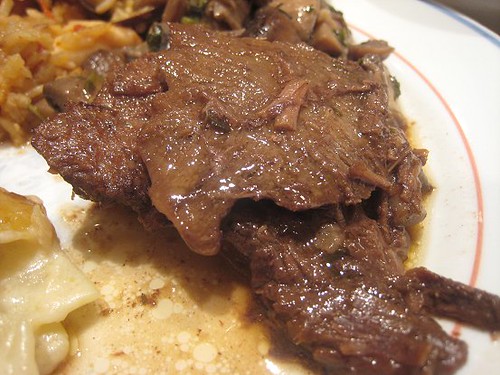
[ts]
The photos do not do this dish justice. So tender, so flavorful, so good!
See the rest of our Spanish-themed New Year's Eve Menu here.
Enjoyed this post? Why not subscribe to our blog? Subscribe via reader or subscribe via email. Thank you! |
Recipe
Lengua Estofada (Beef Tongue Braised in Red Wine and Veal Stock)
This was the proportions I used for our party. Feel free to halve or even divide the recipe by 4. Our beef tongues were about 3-4 pounds each.
4 beef tongues (approx. 3-4 lbs each)
3 ripe tomatoes, large dice
2 large onions, large dice
4-6 carrots, large pieces
handful black peppercorns
10 sprigs to 1 bunch parsley
4 bay leaves
5-8 thyme sprigs
anchovies (optional)
pinch ground cinnamon
2 cloves
red wine
veal or beef stock
Use as much or as little of each liquid, as long as there is enough liquid to cover the meat.
Soak the tongues in water overnight.
Bring a large pot of water to boil. Add the tongues and boil for about 15 minutes. Take out of the water and let cool until cool enough to handle. Discard water. Peel the tongue using a knife.
Alternatively, one can peel the tongue until after braising.
In a large pot, heat oil over medium heat. Add the onions and carrots and sweat. Add tomatoes and cook for a few seconds. Add tongues into the pot, and cover with red wine and/or stock. Add the rest of the ingredients. Bring the liquid to a boil, then turn the heat to low. Cover the pot and simmer for about 3 hours, or until the tongues are tender.
Alternatively, one can also braise the tongues in the oven. Turn the oven to 350F. Place covered pot or roasting pan into the oven and braise for about 3 hours, or until the tongues are tender.
Take tongues out of braising liquid. Slice.
Strain the braising liquid. In a saucepan over medium heat, reduce the braising liquid until desired thickness. Adjust seasoning. Serve sauce with the sliced tongue.
[eatingclub] Spanish
Tortilla de Patatas (Spanish "Omelette")
Roast Duck and Orange Crêpes with Orange-White Wine Sauce
Sardinas na Bangus (Milkfish in the style of Sardines)
Red Wine-braised Squid with Potatoes and Chorizo
Philippine Beef Salpicao (and a Spanish variation)
Stewed Tripe, Spanish-style
Lengua Estofada (Beef Tongue Braised in Red Wine and Veal Stock)
Bacalao con Patatas (Baked Salt Cod and Potatoes)
Salsa Romesco ("Queen of the Catalan Sauces!")
Grilled Calçots (Green Onions) with Salsa Romesco
Empanada de Pavo
(Galician-style Meat Pie with Turkey Filling), plus Turkey Cracklings!
Fideuá (Spanish Seafood Noodle "Paella")... and Paella
Cocido (Spanish Stew with Various Pork Cuts)
Slow-Roast Pork Shoulder, Two Ways






I once read that tongue was considered lesser meat b/c of the lascivious connotations. And, i totally agree about the strawberry thing.
ReplyDeleteGood job! Once it's cut, it looks like regular beef except it is so tender it melts.
ReplyDeleteAlthough I know I'd try it, I still have difficulty getting past the thought "ewww, that's a cow's TONGUE, it used to chew GRASS and it still looks dirty...", but I'm generally all for variety meats and I wouldn't draw the line here (and my father wouldn't even stop to think about it). I think people still have issues with eating the heads of things, they get lumped into the offal category along with innards...
ReplyDeleteMmmmm... Tongue. The best part of the cow! When done right, it is very tender and so soft. Thanks for doing a tongue dish!
ReplyDeleteGood point about tongue just being a muscle rather than innards. That would make it easier for those not into offal. After all that work, it looks like you tongue turned out great.
ReplyDeleteOMG that tongue close up wud probably freak a lot of people out...but i love me tongues.
ReplyDeletei must admit that i normally don't peel the tongue, simply prick holes all over it...i probably should, as the texture of the tongue surface freaks sc out and totally puts him off tongue forever :D
Wow, I've only had tongue in tacos, you ladies are much more daring than me
ReplyDeleteI love the fact that you've tackled tongue. I haven't eaten it since I was a child (my mom prepared it on one or two occasions)... but you get big kudos for buying an unpeeled tongue and prepping it yourselves!
ReplyDeleteOMG I've never seen it like that before, always cooked. THe final dish looks so good!
ReplyDeleteI love tongue! My grandfather used to eat it raw. That....I don't love. But THIS looks DELICIOUS! Also kudos on making your own veal stock. I'm so lazy. Sigh.
ReplyDeleteLengua estofada is one of my favorite party dishes, I don't know what possessed me as a kid to eat tongue but I'm glad I did. I like the stock turned into a gravy, yum :)
ReplyDeleteI love tongue but haven't tried cooking with it yet. Just me. And the tongues I see at the store are always so huge. Don't know what I'd do with all of it.
ReplyDeletemaybelle's mom:
ReplyDeleteOh, I diodn't know about the lascivious connection. Hehe. Yeah, it's harmless! It's just like a straweberry! =)
momgateway:
Exactly. Totally nothing to be afraid of.
Stamatia:
Yeah. But, I only have a problem with actual innards myself. The other parts are OK with me. =)
Sherman:
You missed out!
Marvin:
It was sort of labor-intensive, but not really. I think the practice on the first tongue helped a lot.
Mochachocolata Rita:
OH REALLY?!?! You leave the skin still on! I've never seen that before... and I don't know how I feel about eating tongue with the skin still on. LOL.
kat:
It's just meat. =)
Lo:
Yeah, it was a pretty good experience prepping them.
pigpigscorner:
Thanks!
Choosy Beggar Tina:
Oh. Raw. Hmm.
Oh, lazy is us! Welcome to our world.
Manggy:
Yeah, I think we just ate the dish as kids during parties. I don't know if anybody ever explained they were tongue, but we more or less figured it out.
Wandering Chopsticks:
Cook it for a get-together! =) It'll be a labor of love; so just invite worthy people. LOL.
Here's a better way to clean the tongue. Boil water in a casserole. When it's hot, dip a portion of the tongue for 3 seconds then scrape the white portion with a knife. Repeat it until the whole tongue is clean.
ReplyDelete